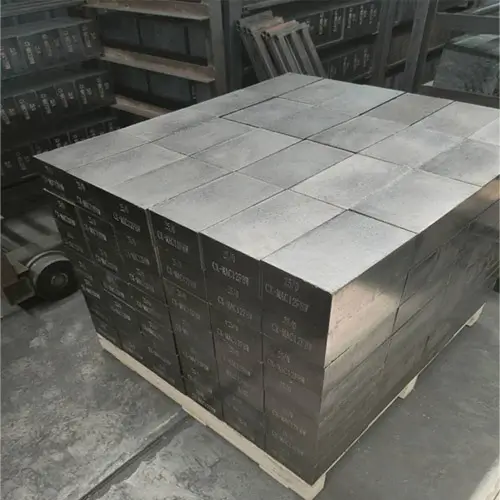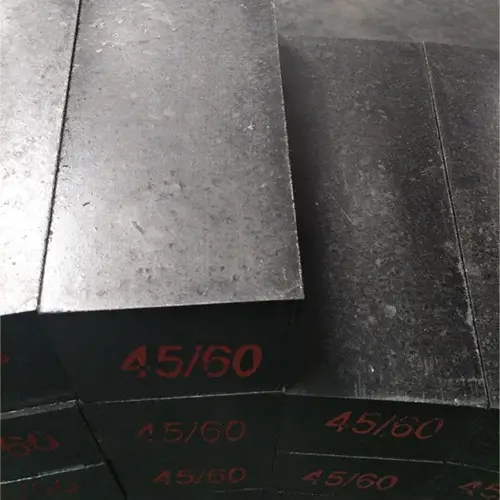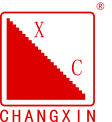Waste magnesium carbon brick refractory materials regeneration brick-making technology
Iron and steel production needs to consume a large number of magnesium-carbon bricks, for the regeneration of magnesium-carbon refractory materials after use provides an outlet, so the regeneration of magnesium-carbon refractory materials after use of the brick technology has become the focus of the development of domestic and foreign steel mills and refractory material manufacturers. Domestic Baosteel, Jigang and other regeneration of magnesium-carbon bricks after the use of brick technology development, and on-site trial.
1.Baosteel’s recycled magnesia-carbon refractory brick making technology
Baosteel will be used after the magnesium carbon brick after removing the slag layer, picking, magnetic separation, crushing, crushing, screening and other processing to get the regeneration of granular materials, high temperature chemical reaction method of hydration to remove the regeneration of Al4C3. 80% of the regeneration of materials and 20% of the new raw materials made of RanSheng magnesium carbon bricks performance exceeded the corresponding national magnesium carbon bricks A level in the Baosteel branch of the steel mill 300t ladle of the slag line In the slag line of 300t ladle of Baosteel branch company, the service life is 82 furnaces, which has reached the level of magnesium carbon bricks normally used in Baosteel steelmaking plant and exceeded the national industry standard.
2.Regeneration brick making technology of used magnesium carbon refractory materials in Jigang
Jigang will be used after the magnesium-carbon bricks to remove the etching layer, the first coarse broken into ≤ 50mm particles, and then put into the sand mixer mixing, at the same time adding composite additives to reduce the binding strength of the resin and promote the hydration of Al4C3. After trapping the material for 24h, it was crushed by milling. After sieving, particles ≤1mm were then milled, and the particle size of the milled fine powder was controlled within 0.1mm. In the recycled material obtained, the mass fraction of >1mm particles is 40%~45%, ≤1mm is 25%~30%, and the fine powder is 30%~35%.
When making regenerated MgO-C bricks, in addition to recycled materials, other raw materials for the normal production of carbon products used in the workshop of electrofused magnesium sand, graphite and thermosetting resin, after testing and adjusting, the formation of two more mature formulas, in which the introduction of recycled materials, respectively, for the introduction of 68% and 50%.
Regeneration of bricks and new bricks used together for 160t ladle work lining, LF refining ratio of 73%, refining time average of 42min, with to 32 furnaces for minor repairs for 3 layers of slag line, normal use of 66 furnaces down the line, found that regeneration of bricks erosion of the most serious parts of the remnants of the brick thickness of 84mm, the new bricks 87mm; other parts of the regeneration of the remnants of magnesium-carbon bricks thickness of 123mm, the new bricks 125mm, indicating that regeneration of bricks is completely Can meet the requirements of use.

Waste magnesium carbon bricks recycled into ladle spraying material
Baosteel Meigang Company will be dismantled at the ladle slag line MgO-C bricks after treatment for the production of ladle spray filler, the field application proved to be able to replace the existing spray filler.
1.After-use magnesium carbon brick regeneration treatment process
The regeneration process of after-use MgO-C bricks adopted by Meigang is as follows: after-use magnesium-carbon bricks → removal of surface slag iron crushing → iron removal → screening → qualified raw materials, the chemical composition of after-use MgO-C bricks is shown in Table 2.As the graphite added to the production of bricks inches is finely powdered, the content of C in the crushed and processed 1~0 particles is high.
2.Field Application Results of Spray Patching Compound
Due to the thermal spray patching, the water in the sprayed layer will evaporate quickly. Even if there is Al4C3 in it, it is too late to be hydrated, so the recycled spray patch was not hydrated. Five tons of recycled patching material were produced, and the amount of recycled material introduced was 20%. Conducted 25 times of hot ladle spray patch test, the results show that the regeneration of spray patch material adhesion rate is good, dense spray layer, fast curing speed, durability up to 6 furnaces, while the new spray patch material can only be used for 4 to 5 furnaces. It shows that the regenerated patching material can completely replace the new patching material.
Key Technical Issues in the Recycling of After-use Magnesium and Carbon Refractories
If magnesium-carbon refractory materials are to be successfully recycled with high added value, the problems of Al4C3 and false particles must be solved.
1.Hydration removal of Al4C3
MgO-C brick is a refractory product made of magnesium sand, graphite, carbonaceous binding agent and added antioxidant through mixing, molding and heat treatment at about 220℃. Metal Al powder is one of the antioxidants commonly used in magnesium carbon bricks, AI is easy to react with C to produce Al4C3 at high temperature, which can improve the high temperature performance and antioxidant performance of refractory materials, but AI4C3 is very easy to hydrate, and it will react with water produced by bonding agent as follows at high temperature:
Al4C3+12H2O=4AI(0H)3+3CH4↑
The reaction produces CH4 gas, at the same time the solid volume generated by the reaction also increased by 1.65 times, regeneration of bricks will lead to product expansion, pulverization and cracking, affecting the performance, so after the regeneration of magnesium carbon bricks must be hydrated to pre-remove the Al4C3 component. Commonly used hydration methods are water washing method and high temperature steam method, room temperature using water washing method usually water immersion time ≥ 24h.
Since metal AI powder is added to MgO-C bricks in the form of fine powder and Al4c3 is mainly concentrated in <1mm fine powder, Liaoning University of Science and Technology (LUST) investigated the optimal hydration technology for this part of the material at different temperatures. Laboratory research found that when the hydration of Al4c3 is carried out at room temperature (25℃), the amount of water added (mass) is 2 times of the material, and the hydration time is 6h for the best effect; at 60℃, the amount of water added (mass) is 1.5 times of the material, and the hydration time is 4h for the best effect; at 90℃, the amount of water added (mass) is the same as that of the material, and the hydration time is 6h for the best effect.
2.Removal of false particles
Recycling of magnesium carbon refractories, usually after picking, slag removal, crushing, screening and other processes, in the initial crushed particles there are a large number of aggregate and matrix coexisting false particles, false particles of low bulk density, pores and cracks and other defects, reuse will significantly reduce the bulk density of the recycled products, molding prone to secondary crushing, affecting the quality of the product, after the use of magnesium carbon refractory materials to achieve high added value To realize the high value-added utilization of the used magnesium and carbon refractories, it is necessary to remove the false particles. False particles removal methods include grinding method, impregnation method, flotation method, burn loss method, usually used is the grinding method. The operation of the grinding method is relatively simple, and the fine powder on the surface of the granular material can be stripped off by grinding, realizing the separation of aggregate and matrix.
Wuhan University of Science and Technology on the removal of false particles technology research, found that after the residual bricks by direct crushing of large particles is mainly fine powder wrapped in the original particles on the surface of the formation of false particles, the use of mixer and wheel mill for processing of granular materials can be achieved by removing the “false particles” of the effect, but the wheel mill processing time is the shortest, the highest efficiency, magnesium carbon granular materials, the most efficient. The best time for magnesium carbon granule processing is 7min, too long time will lead to granule material over-crushing, so that the bulk density of granule material with the increase of crushing time and reduce.
Prospect analysis of the recycling of waste magnesium carbon bricks
As the country’s steel production capacity continues to increase, capacity replacement has become an important development path for steel companies. In the next few years, it is expected that there will be a large number of steel mills from the converter, electric furnaces, refining furnaces, ladles and other thermal equipment removed from the waste refractory materials. In these waste refractories, magnesium and carbon accounted for nearly 60% or so, if it is recycled, not only can reduce solid waste emissions, but also reduce the cost of refractories, saving magnesium sand, graphite and other mineral resources, with multiple environmental significance, economic benefits and social significance.
From the perspective of circular economy, the recycling of magnesium and carbon refractories after use is a recycling process of solid waste in steel mills, which is an effective means for steel mills.
From the economic benefits, the current steel mill operations have entered the era of micro-profit or no profit, to survive must be transformed and upgraded, refinement of the operation, to build a new profit under the new normal point of newborn. Anshan Iron and Steel, the annual generation of 50,000t of waste refractory materials, if you can realize the recycling, will gain considerable profits, so that environmental protection by the steel plant’s investment in the project to the profit-making project transformation. To magnesium carbon refractory materials, for example, regeneration of magnesium carbon material is used in steel mills after magnesium carbon bricks after processing of secondary resources, with its replacement of part of the fused magnesium sand can make magnesium carbon bricks to reduce the cost of raw materials of nearly 1,000 yuan / t, the economic benefits are significant.
After the regeneration of magnesium carbon bricks have a variety of ways, can be used for the production of magnesium carbon bricks, ladle spray filler, intermediate packet thousand vibration material, from domestic and foreign mature experience, through the adoption of appropriate technical measures to remove the regeneration of the material in the Al4C3, false particles, and other harmful components, can be realized under the premise of not reducing the quality of the product to realize the use of high-value-added. Steel mills should pay attention to the regeneration and utilization of magnesium carbon bricks after use to open up new ways for environmental protection and efficiency.

